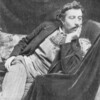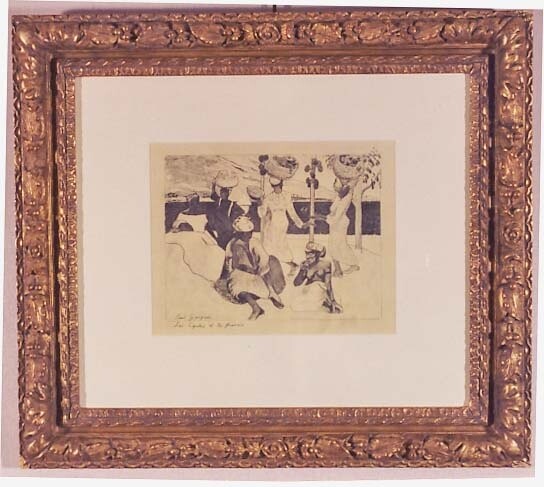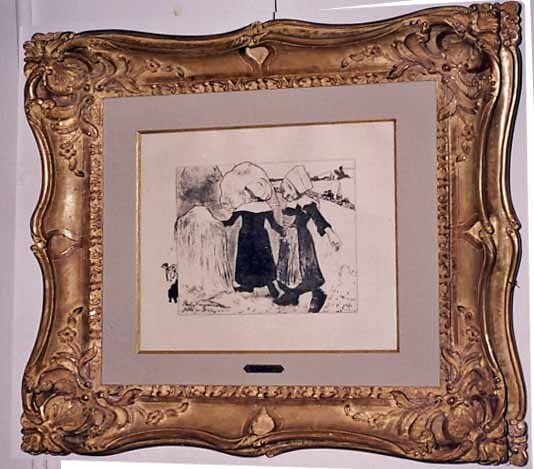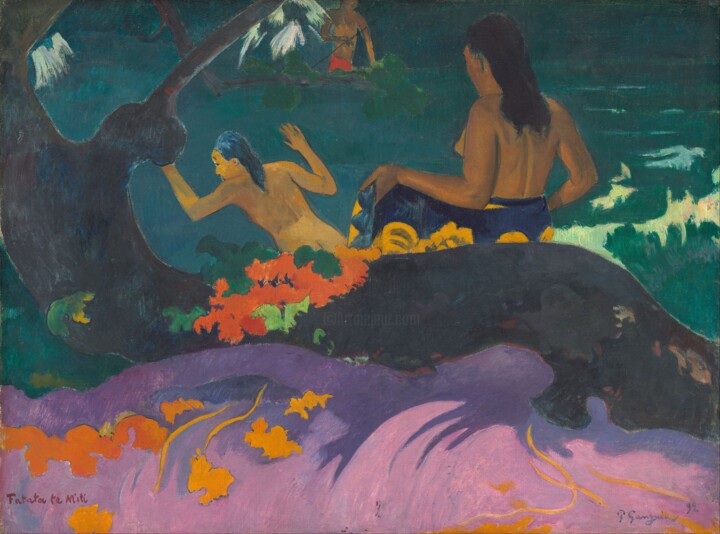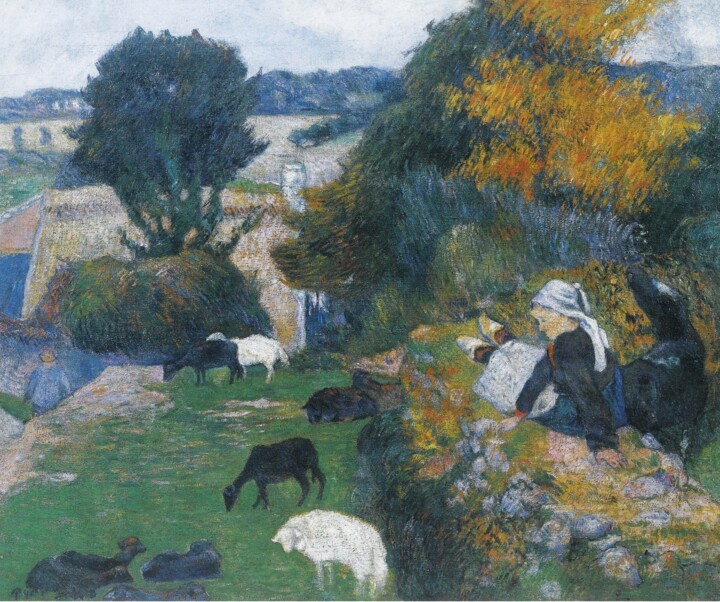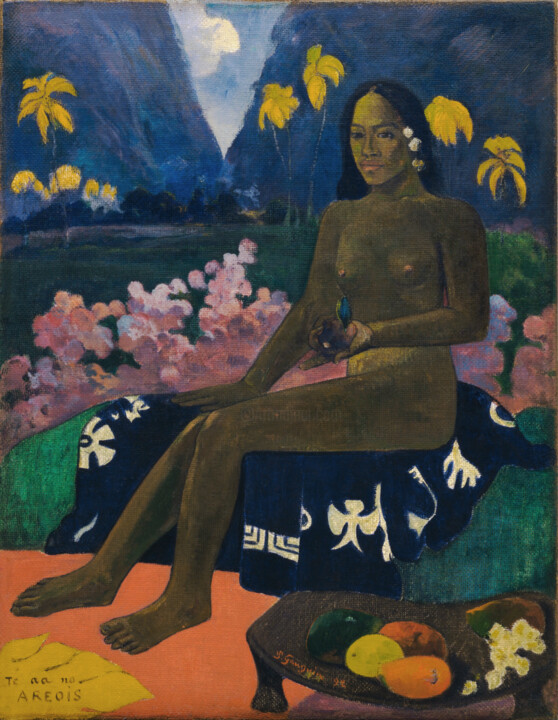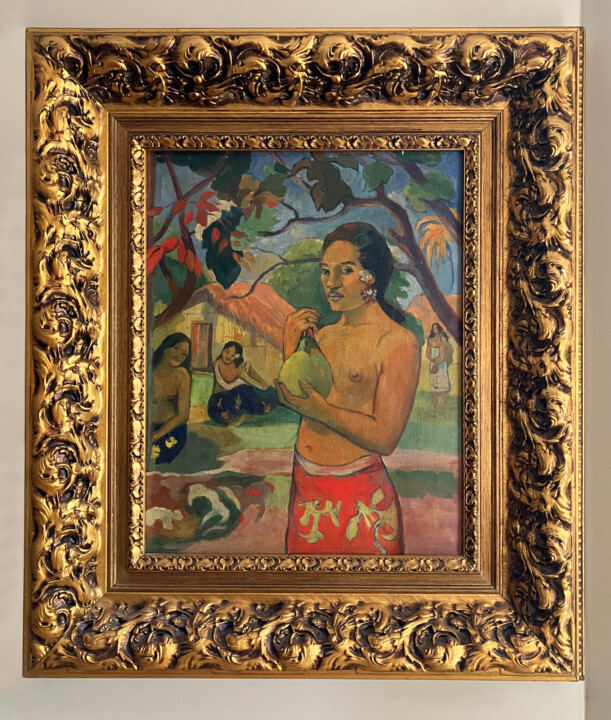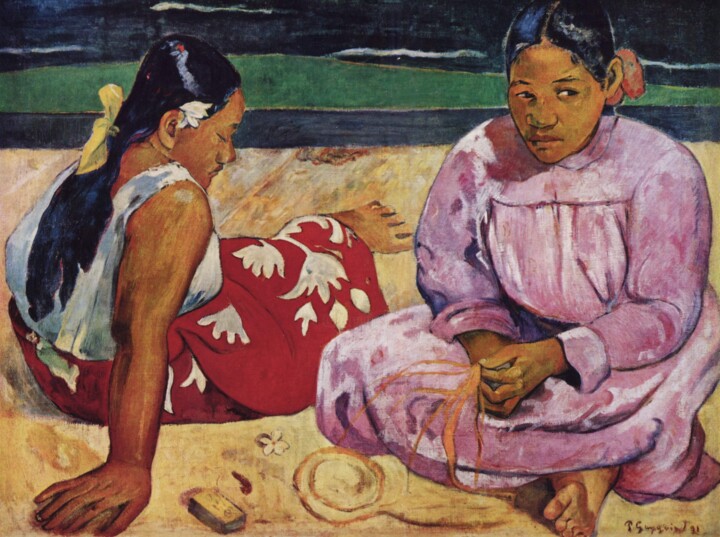 Paul Gauguin, Self-Portrait in a Hat, 1893. Oil on canvas, 45 cm × 38 cm. Paris: Musée d’Orsay.
Paul Gauguin, Self-Portrait in a Hat, 1893. Oil on canvas, 45 cm × 38 cm. Paris: Musée d’Orsay.
Who was Paul Gauguin?
Paul Gauguin (1848-1903) was a French post-impressionist painter who is well-known for his use of bold colors, simplified forms, and his incorporation of themes from indigenous cultures in his work. He was born in Paris and worked as a stockbroker before devoting himself to painting.
Gauguin's artistic style was influenced by his travels to various places, including Tahiti, where he lived for several years. In his paintings, he often depicted scenes of Tahitian life, landscapes, and figures. He was also known for his use of symbolism and his rejection of traditional Western art techniques.
Gauguin's work was not widely recognized during his lifetime, but he is now considered a major figure in the development of modern art. His influence can be seen in the work of many artists who came after him, including Pablo Picasso and Henri Matisse.
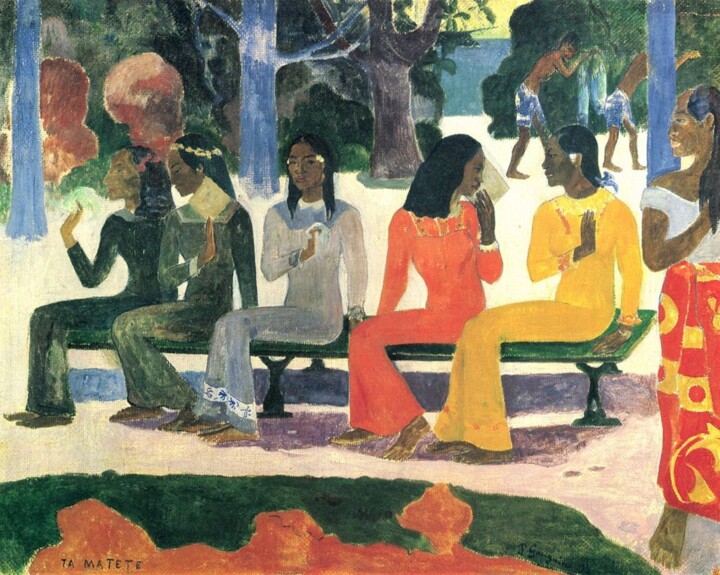 Paul Gauguin, The Market, 1892. Oil on canvas, 73 cm × 92 cm. Basel: Kunstmuseum Basel.
Paul Gauguin, The Market, 1892. Oil on canvas, 73 cm × 92 cm. Basel: Kunstmuseum Basel.
Key concepts
- Post-Impressionism: Paul Gauguin was a Post-Impressionist painter, meaning he rejected the naturalism and scientific approach of the Impressionist movement in favor of expressing subjective emotions and symbolic meanings through art. Gauguin's work often incorporated bright colors, simplified forms, and flattened perspectives to convey a sense of spiritual or emotional depth.
- Tahiti: Gauguin is famous for his depictions of Tahitian life, having spent several years living in the South Pacific. He was drawn to the exoticism and simplicity of the Tahitian culture, which he believed offered a way to escape the materialism and industrialization of the Western world. Gauguin's paintings of Tahitian landscapes and people are characterized by their vivid colors and dreamlike quality.
- Symbolism: Gauguin was part of the Symbolist movement, which sought to convey abstract ideas and emotions through art. He often included symbolic elements in his paintings, such as mysterious figures or mythical creatures, to suggest deeper meanings beyond the surface appearance of the image.
- Primitivism: Gauguin was also associated with the Primitivist movement, which celebrated the art and culture of non-Western societies as more authentic and spiritually pure than Western civilization. Gauguin's interest in the Tahitian culture was part of this broader fascination with the idea of the "noble savage" and the belief that primitive cultures had much to teach modern society.
 Paul Gauguin, Nafea faa ipoipo, 1892. Oil on canvas, 105×77,5 cm. Riehen: Beyeler Foundation.
Paul Gauguin, Nafea faa ipoipo, 1892. Oil on canvas, 105×77,5 cm. Riehen: Beyeler Foundation.
Childhood
Paul Gauguin's childhood was marked by tragedy and upheaval. He was born in Paris in 1848 to a French father and Peruvian mother, but his family moved to Peru when he was only about two years old. However, his father died suddenly and his mother later brought the family back to France. Gauguin's mother was unable to support the family alone, so she sent him to live with his paternal grandfather in Orleans. In his teens Gauguin enlisted in the merchant navy and spent several years traveling the world. Eventually he settled in Paris and began working as a stockbroker, but continued to cultivate his interest in art as a hobby. Only later did he decide to devote himself full-time to painting and began studying with several artists in Paris. Although Gauguin's childhood was difficult, his experiences as a young man traveling the world and encountering different cultures would profoundly influence his art.
 Paul Gauguin, Merahi metua no Tehamana. Chicago: Art Institute of Chicago.
Paul Gauguin, Merahi metua no Tehamana. Chicago: Art Institute of Chicago.
Artistic training
After meeting the painter Emile Schuffenecker and listening to the advice of his teacher, Gustave Arosa, he decides to become a self-taught artist and devote himself to painting. His teacher had a large art collection that included works by Eugène Delacroix, which Paul looked at to get ideas.
Paul Gauguin was largely self-taught as an artist. Although he briefly studied with various French academic painters in the 1870s and 1880s, including Camille Pissarro and Armand Guillaumin, he did not receive formal training in art. Instead, he learned from studying the works of other artists and from experimenting with different techniques and styles on his own. He was known for his innovative use of color and bold, simplified forms, which set him apart from his contemporaries and contributed to his reputation as a leading figure in the Post-Impressionist movement.
 Paul Gauguin, The Siesta, 1892 to 1894. Oil paint on canvas, 88.9 by 116.2 centimetres. New York: MET.
Paul Gauguin, The Siesta, 1892 to 1894. Oil paint on canvas, 88.9 by 116.2 centimetres. New York: MET.
Edgar Degas
Edgar Degas was Gauguin's most admired contemporary artist, so much so that a great influence on his work can be detected from the very beginning with his figures and interiors. Paul, who had a deep reverence for Degas's artistic dignity and tact, forged a sdane and enduring friendship with the latter, which lasted throughout his artistic career until his death. Degas was also one of Gauguin's early supporters, buying his as well and convincing the dealer Paul Durand-Ruel to do the same. Similarly, Gauguin purchased works by Degas in the early and mid-1870s.
Technique and style
Paul Gauguin was a French post-impressionist painter known for his innovative style and use of color. He rejected the traditional techniques of European painting and instead drew inspiration from the art of other cultures, particularly those of Polynesia.
Gauguin's style was characterized by flat shapes and bold colors. He simplified forms and used strong outlines to create a sense of decorative pattern. He often used pure, bright colors and experimented with color harmonies to create a powerful visual impact.
One of Gauguin's most distinctive techniques was the use of woodcuts and other forms of printmaking. He was particularly interested in the way that woodcuts could flatten forms and create bold, graphic patterns. He also experimented with other media, including ceramics and sculpture.
Gauguin was a deeply influential figure in the development of modern art. His use of color, form, and technique inspired many artists who followed him, including the Fauvists and the Expressionists. His work continues to be admired for its beauty, its technical innovation, and its powerful sense of emotion and meaning.
 Paul Gauguin, Self-Portrait with Halo and Snake, 1889. Oil painting on wood, 79 cm × 51 cm. Washington, D.C: National Gallery of Art.
Paul Gauguin, Self-Portrait with Halo and Snake, 1889. Oil painting on wood, 79 cm × 51 cm. Washington, D.C: National Gallery of Art.
The most famous works
 Paul Gauguin, Vision after the Sermon, 1888. Oil on canvas, 72.2 cm × 91 cm. Edinburgh: Scottish National Gallery.
Paul Gauguin, Vision after the Sermon, 1888. Oil on canvas, 72.2 cm × 91 cm. Edinburgh: Scottish National Gallery.
- "Vision After the Sermon" (1888) - This painting depicts a group of Breton women in prayer, with a vision of Jacob wrestling with an angel superimposed over the scene.
 Paul Gauguin, The Yellow Christ, 1889. Oil on canvas, 92×73 cm. Buffalo: Albright-Knox Art Gallery.
Paul Gauguin, The Yellow Christ, 1889. Oil on canvas, 92×73 cm. Buffalo: Albright-Knox Art Gallery. - "The Yellow Christ" (1889) - This painting features a figure of Christ on the cross against a bright yellow background, set against the rugged landscape of Brittany.
- "Tahitian Women on the Beach" (1891) - This painting shows two Tahitian women sitting on a beach, with vibrant colors and a flattened perspective that reflects Gauguin's interest in non-Western art.
- "Where Do We Come From? What Are We? Where Are We Going?" (1897) - This large-scale painting is an allegory of human life, depicting figures at various stages of life and a group of women who represent the three questions in the title.
- "Two Tahitian Women" (1899) - This painting shows two women from Tahiti, with bright colors and simplified forms that reflect Gauguin's interest in the art of other cultures.
- "The Spirit of the Dead Watching" (1892) - This painting shows a nude Tahitian woman lying on a bed, with a ghostly figure in the background representing the spirit of the dead.
 Paul Gauguin, Spirit of the Dead Watching, 1892. Oil on canvas, 116.05 cm × 134.62 cm. Albright Knox Art Gallery.
Paul Gauguin, Spirit of the Dead Watching, 1892. Oil on canvas, 116.05 cm × 134.62 cm. Albright Knox Art Gallery.
Focus on The Spirit of the Dead Watching
"The Spirit of the Dead Watching" is a painting created by French artist Paul Gauguin in 1892. It depicts a young Tahitian woman lying naked on a bed while a ghostly figure watches over her. The painting is part of Gauguin's larger body of work inspired by his time living in Tahiti, where he sought to escape Western civilization and immerse himself in a more primitive and exotic culture.
The painting has generated controversy due to its erotic and voyeuristic undertones, as well as its portrayal of a young native woman as a sexual object for the male gaze. However, some scholars argue that the painting should be viewed as a commentary on colonialism and the destructive impact of Western imperialism on native cultures.
Despite the controversy surrounding it, "The Spirit of the Dead Watching" remains a significant work in Gauguin's oeuvre and a notable example of the influence of non-Western art on European modernism.
 Paul Gauguin, Two Tahitian Women, 1899. Oil on canvas, 94 cm × 72 cm. New York: MET.
Paul Gauguin, Two Tahitian Women, 1899. Oil on canvas, 94 cm × 72 cm. New York: MET.
Focus on Two Tahitian Women
"Two Tahitian Women" is a painting created by French artist Paul Gauguin in 1899 during his second trip to Tahiti. The painting depicts two topless women, one holding mango blossoms, on the Pacific Island of Tahiti. The women are portrayed in a stylized manner, with simplified forms and bright colors.
The painting is part of Gauguin's larger body of work inspired by his time living in Tahiti, where he sought to escape Western civilization and immerse himself in a more primitive and exotic culture. However, some critics have pointed out that Gauguin's idealized and romanticized depictions of Tahitian life were not necessarily accurate or representative of the reality experienced by native people.
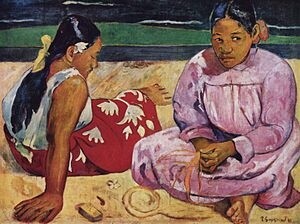 Paul Gauguin, Tahitian Women on the Beach, 1891. Oil on canvas, 69 cm × 91 cm. Paris: Musée d'Orsay.
Paul Gauguin, Tahitian Women on the Beach, 1891. Oil on canvas, 69 cm × 91 cm. Paris: Musée d'Orsay.
Focus on Tahitian Women on the Beach
"Tahitian Women on the Beach" is a painting created in 1891 by the French Post-Impressionist artist Paul Gauguin during his trip to Tahiti. The painting depicts two Tahitian women sitting on a tropical beach.
The painting is known for its vibrant colors and use of flattened, two-dimensional forms. Gauguin was heavily influenced by the art of non-Western cultures, particularly Polynesian art, and he incorporated elements of this style into his own work. The painting also reflects Gauguin's interest in depicting Tahitian life and culture.
"Tahitian Women on the Beach" is now held in the collection of the Musée d'Orsay in Paris, France, and is considered a significant work in the history of modern art.
 Paul Gauguin, Where do we come from? What are we? Where are we going, 1897. Oil on canvas, 139.1×374.5 cm. Boston: Museum of Fine Arts.
Paul Gauguin, Where do we come from? What are we? Where are we going, 1897. Oil on canvas, 139.1×374.5 cm. Boston: Museum of Fine Arts.
Focus on Where Do We Come From? What Are We? Where Are We Going?
"Where Do We Come From? What Are We? Where Are We Going?" is a painting created by French Post-Impressionist artist Paul Gauguin in 1897. The painting is a large-scale triptych, which means it is divided into three panels.
The left panel shows three figures, including a baby, a young woman, and an old woman. The central panel depicts several people gathered around a bowl of fruit, while the right panel shows a crouching figure and a horse. The painting is known for its vivid colors, bold lines, and the dream-like quality of its composition.
The title of the painting reflects Gauguin's interest in exploring fundamental questions about the human experience, such as the origins of life, the nature of humanity, and the ultimate fate of human existence. It is also considered a reflection of Gauguin's personal journey, as he moved from France to Tahiti in search of a more authentic, primitive way of life.
"Where Do We Come From? What Are We? Where Are We Going?" is now held in the collection of the Museum of Fine Arts in Boston, Massachusetts, and is considered one of Gauguin's most important works.
 Paul Gauguin, The Green Christ, 1889. Oil painting on wood, 92 cm × 73 cm. , Brussels: Royal Museums of Fine Arts of Belgium.
Paul Gauguin, The Green Christ, 1889. Oil painting on wood, 92 cm × 73 cm. , Brussels: Royal Museums of Fine Arts of Belgium.
Travels and friendship
Panama Canal
In 1887 Gauguin left France with his painter friend Charles Laval. His dream was to buy land on the Panamanian island of Taboga, where he declared he wanted to live in greater contact with nature. When he reached the port city of Colón, Gauguin ran out of money and found work as a laborer in the French construction of the Panama Canal. After an episode of being arrested in Panama and discovering that the land on Taboga had a very high price tag he decided to leave Panama.
Martinique
After Panama Gauguin and Laval moved to St. Pierre, on the Caribbean island of Martinique, a French colony. At first the hut they lived in suited him well and he enjoyed observing people in their daily activities, but during the summer the weather was hot and the hut leaked in the rain. Gauguin also suffered from dysentery and marsh fever. During his stay in Martinique, Gauguin completed 11 known paintings, many of which seem to have come from his hut. His letters to Schuffenecker express an excitement about the exotic place and the natives depicted in his paintings.
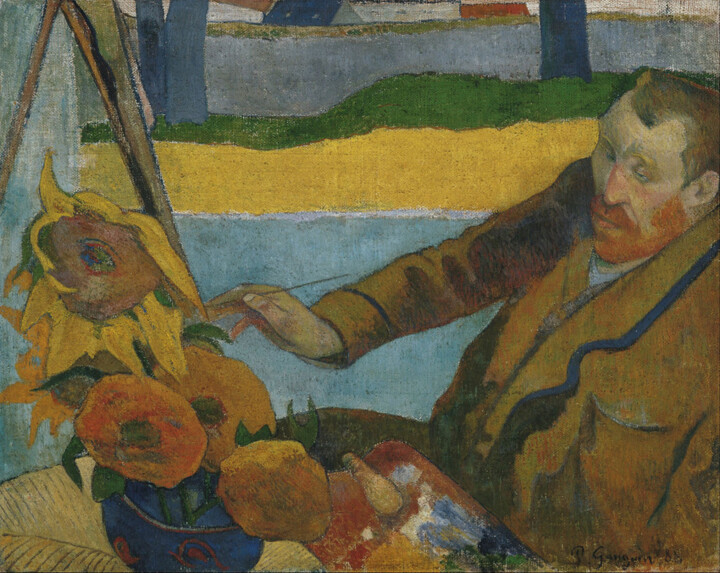 Paul Gauguin, Van Gogh Painting Sunflowers, 1888. Oil on juta, 73×91 cm. Amsterdam: Van Gogh Museum.
Paul Gauguin, Van Gogh Painting Sunflowers, 1888. Oil on juta, 73×91 cm. Amsterdam: Van Gogh Museum.
Vincent Van Gogh's Friendship
Paul Gauguin and Vincent van Gogh were two influential artists who had a brief and intense friendship in the late 19th century.
They met in Paris in 1887 and quickly formed a bond over their shared love of art. Van Gogh was impressed by Gauguin's innovative use of color and composition, while Gauguin was intrigued by Van Gogh's emotional intensity and raw expression.
In 1888, Van Gogh invited Gauguin to join him in Arles, in the south of France, to establish an artists' colony. However, their time together was fraught with tension and conflict, due to their different personalities and approaches to art.
Van Gogh was known for his impulsive, passionate nature and struggled with mental illness, while Gauguin was more reserved and detached. Their artistic styles also differed greatly, with Van Gogh favoring bold, impasto brushstrokes and Gauguin using flatter, more decorative patterns.
Their relationship came to a dramatic end in December 1888, when Van Gogh famously cut off his own ear during a heated argument with Gauguin. After this incident, Gauguin left Arles and the two never saw each other again.
Despite their troubled friendship, Gauguin and Van Gogh's influence on each other's work cannot be denied. They both pushed the boundaries of traditional art and paved the way for the modernist movement of the 20th century.
 Paul Gauguin, Arearea, 1892. Oil on canvas, 75×94 cm. Paris: Musée d'Orsay.
Paul Gauguin, Arearea, 1892. Oil on canvas, 75×94 cm. Paris: Musée d'Orsay.
Tahiti: first part
Gauguin set sail for Tahiti on April 1, 1891, his stated intent being to escape European civilization and all things artificial and conventional. Despite this he spent the first three months in Papeete, the capital of the colony and already greatly influenced by European culture. He decided to open his studio in Mataiea, setting up in a native-style bamboo hut. There she made paintings depicting Tahitian life such as Fatata te Miti (By the Sea) and Ia Orana Maria (Hail Mary). Gauguin later wrote a travelogue of taking a 13-year-old girl as his wife as a native or vahine (the Tahitian word for "woman"), a marriage contracted over the course of a single afternoon. This was Teha'amana, who became pregnant by him in the late summer of 1892. Teha'amana was the subject of several of Gauguin's paintings. In late July 1893, Gauguin decided to leave Tahiti and would never see Teha'amana and his son again.
Tahiti: second part
Gauguin returned to Tahiti in 1895. His return is marked by disillusionment with the Parisian art scene. In Tahiti he lived a seemingly comfortable life as an artist-colonist near Papeete, supporting himself through an increasingly steady stream of sales and the support of friends and benefactors. He built a spacious house of reeds and thatch in Puna'auia, in an affluent area ten miles east of Papeete, inhabited by wealthy families, in which he installed a large studio, sparing no expense. the artist abroad also played an important role in local politics, contributing incisively to a local newspaper opposing the colonial government. At least for the first year he did not make any paintings, as he concentrated on sculpture. When he resumed painting, it was to continue his long series of sexually charged nudes. Thereafter his health deteriorated markedly and he was hospitalized several times for a variety of ailments. Gauguin blamed the tropical climate, although his biographers agree that it must have been syphilis. In addition to his health it was his debts that brought him to the brink of despair. From this Taitian period is his relationship with Pahura (Pau'ura) a Tai, daughter of neighbors in Puna'auia, who was 14 1/2 years old, by whom the artist had two children.
 Paul Gauguin, Mahana no atua, 1894. Oil on canvas, 68.3×91.5 cm. Chicago: Art Institute.
Paul Gauguin, Mahana no atua, 1894. Oil on canvas, 68.3×91.5 cm. Chicago: Art Institute.
Marquesas Islands
Gauguin settled in Atuona, on the island of Hiva-Oa, where he arrived on 16 September 1901. He bought a plot of land in the center of the city from the Catholic mission, where he built a sturdy two-story house. Vaeoho, the fourteen-year-old daughter of a native couple who lived in an adjacent valley, despite the artist's sores, gladly lived with him and gave birth to a healthy daughter. In the following years, this love relationship fell apart, and Gauguin became increasingly ill, so that it was difficult for him to even paint.
Death
Paul Gauguin, the French artist, died on May 8, 1903, at the age of 54 in the Marquesas Islands, which are part of French Polynesia in the South Pacific. The cause of his death was most likely a combination of syphilis, heart disease, and possibly also a morphine overdose. Gauguin had spent the last years of his life living in Tahiti and the Marquesas Islands, where he had gone to escape what he saw as the constraints of Western civilization and to immerse himself in the culture and nature of the South Pacific.

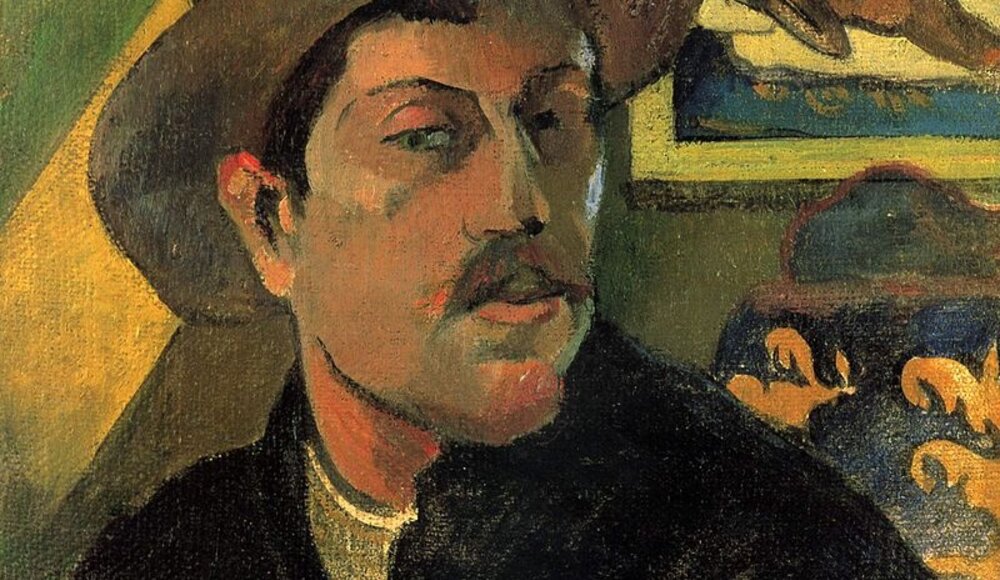
 Selena Mattei
Selena Mattei
